Explainer
- Explainer
- Myanmar coup
‘Soldiers are the greatest peril’: How did Myanmar descend into chaos?
What’s behind the latest coup? Did Aung San Suu Kyi ever really have power? And isn’t Myanmar a democracy?
Myanmar has descended into chaos since a junta seized power from the elected government of Aung San Suu Kyi on February 1. Armed forces and police have fired on demonstrators, who appear undeterred by curfews and a nationwide state of emergency, but the military have also entered shops and houses to attack people. The country is on the brink of collapse and civil war.
More than 500 have been killed, with children among the victims. Thousands of people have been detained, including leaders of the former civilian government. Air strikes have been launched against ethnic minorities and the UN’s special envoy to Myanmar has warned of a possible “multi-dimensional catastrophe in the heart of Asia”.
The most famous person arrested is Suu Kyi, the 75-year-old civilian leader whose party won the November 2020 elections in a landslide. Key allies of the Nobel peace laureate have also been locked up, including Sydney academic Sean Turnell who has long served as an economic adviser. He faces up to 14 years in prison under colonial-era laws.
This latest coup happened after she came into conflict with armed forces commander-in-chief Min Aung Hlaing, who questioned the legitimacy of the November 2020 elections that returned Suu Kyi with a massive majority.
The target of US sanctions under the Global Magnitsky Human Rights Accountability Act for his alleged involvement in human rights abuses against the Rohingya minority and others, Senior General Min Aung Hlaing has for 10 years maintained significant power even as the country has moved towards democracy.
Did Suu Kyi ever really have power? What has triggered this latest turn of events? And wasn’t Myanmar a democracy?
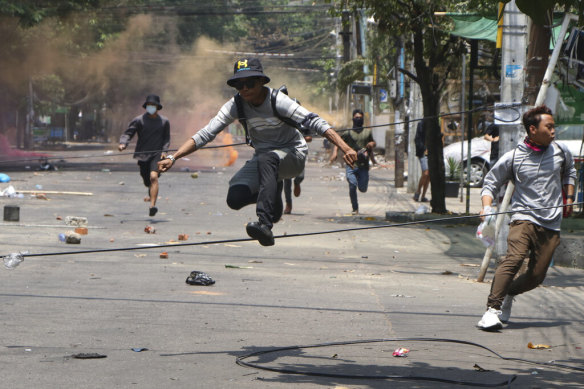
Anti-coup protesters run to avoid military forces during a demonstration in Yangon, Myanmar, on Wednesday. Credit: AP
What do I need to know about Myanmar?
The south-east Asian republic, once a British colony called Burma, lies to the west of Thailand and also shares borders with China, Bangladesh, India and Laos. Officially a federation of states and regions known as the Republic of the Union of Myanmar, it is the world’s 25th most populous nation with 57 million people, nearly 90 per cent of them Buddhist.
Myanmar became independent from Britain in 1948 but endured military rule almost uninterrupted between 1962 and 2011. The generals flirted with “democracy” in 1990 when they held a general election but rejected it when Suu Kyi, then under house arrest, won. Then, a decade ago, a group of generals traded khaki for suits and set up a new, quasi-civilian government. They promised elections, and largely delivered in 2015 when Suu Kyi’s party, the National League for Democracy (NLD), scored a resounding victory. The next election, when the NLD’s five-year term was up, was in November – and the party’s win was even more emphatic.
The military has never handed over power unconditionally, though, and under the junta-drafted constitution of 2008 it holds key positions in the cabinet, picks one of the three vice-presidents and is guaranteed a quarter of the seats in Parliament (which are therefore never up for election).
Myanmar has seven large ethnic groups of which the largest is Burman with about 68 per cent, and the government recognises nearly 200 ethnic minorities and clans. The government does not recognise the Rohingya, a Muslim minority; Myanmar’s military has been accused of waging an attempted genocide against the Rohingya, leading to more than a million displaced people, including about 700,000 in refugee camps in Bangladesh.
Myanmar’s military, called the Tatmadaw, has also been involved in civil wars with state-level armed forces that opposed central rule or rebelled against the oppression of a one-party state. The national government’s recent efforts to broker a truce among the states have yielded mixed results.
Demographically, the country is young: more than a quarter of the population is aged under 14, yet it has one of the lowest rates of spending on education as a percentage of gross domestic product in the world. The CIA World Factbook ranks Myanmar at 175 out of 228 countries for real GDP per capita.
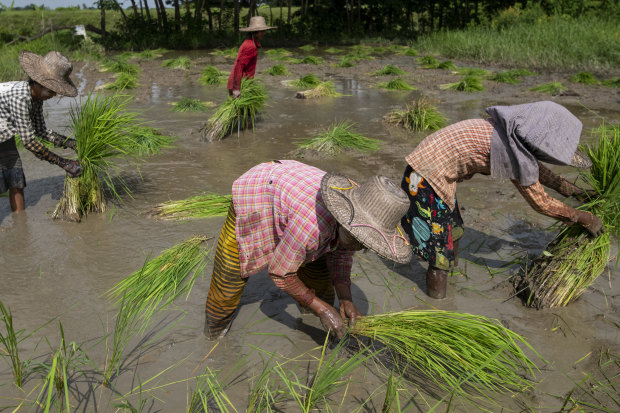
Women working in a paddy field in the Irrawaddy region of Myanmar in August. Credit: Getty Images
Who is Aung San Suu Kyi, and why is she controversial?
Born in British Burma in 1945, Suu Kyi is the daughter of a general who played an important role in the fight to establish an independent Myanmar after World War II. General Aung San was assassinated in 1947, and he remains a hero to the Burmese majority, including to the military leaders who detained Suu Kyi.
A diplomat and scholar, Suu Kyi married Oxford historian Michael Aris and had two children. She was outspoken on human rights issues and confronted the military as its hold on power grew more repressive in the late 20th century. Aris died in 1999.
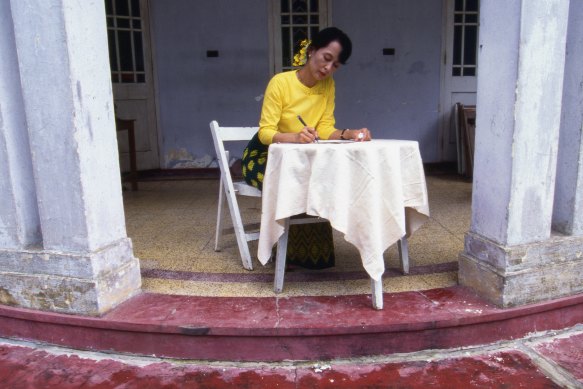
Suu Kyi under house arrest in her dilapidated mansion in Yangon (formerly Rangoon) in 1996.Credit: Getty Images
The pro-democracy movement of 1988 was a turning point for Suu Kyi, who had returned to Myanmar from Britain. The “8888 Uprising” grew during the year, building up to August 8, 1988, a date people considered auspicious. However, the army killed 350 people (activists claim the true toll is thousands) and detained many more. Suu Kyi’s speech urging non-violent resistance at Shwedagon Pagoda in Yangon on September 26, to more than half a million people in the aftermath of the massacre, became an iconic moment.
Adored as “The Lady”, Suu Kyi led the NLD to a landslide victory in 1990 while under house arrest in Yangon. The generals refused to hand over power. Suu Kyi was awarded the Nobel Prize for Peace while detained; she spent about 15 years in total under house arrest before being released in December 2010 during a thaw in relations with the military.
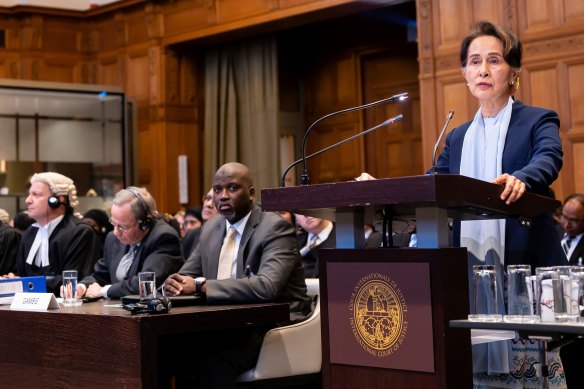
Aung San Suu Kyi defends her country against accusations of the Rohingya genocide at the top UN court in the Hague in the Netherlands on December 11, 2019. Credit: Getty Images
Her election victory in 2015 was hailed as a watershed moment for Myanmar democracy – she was allowed to campaign openly and to actually take power – but there were already questions about whether she had compromised too much of her credibility by engaging with the generals. She was criticised during the campaign for failing to rebuke the military for their longstanding abuses of the Rohingya minority, who had been denied citizenship and the right to vote.
The condemnation grew after she was in office, as the military launched a crackdown that United Nations agencies have likened to genocide, in October 2016. Two years later, at the World Economic Forum, she equivocated by saying “we have to be fair to all sides”.
Amnesty International stripped her of the Prisoner of Conscience Award shortly after while other honours have been revoked. Despite agitation from activists, there is no possibility of rescinding the Peace Prize under the Nobel statutes.
Police charged Suu Kyi for illegally possessing communications equipment, allegedly found during a raid on her house in the capital, Naypyidaw, and when she first faced court in secret on February 16, The New York Times reported she was also charged with contravening a natural disaster management law by interacting with a crowd during the coronavirus pandemic.
The military are both unearthing obscure colonial-era laws and drafting new cybersecurity bills to counter online activism. International Commission of Jurists’ accountability director Kingsley Abbott told the BBC one law, threatening public tranquility, was “so vague and so broad is can pretty much be used to arrest anyone on any pretext”.
“The bottom line is the military is completely above the law, and these developments are really a full-frontal assault on human rights and the rule of law in Myanmar.”
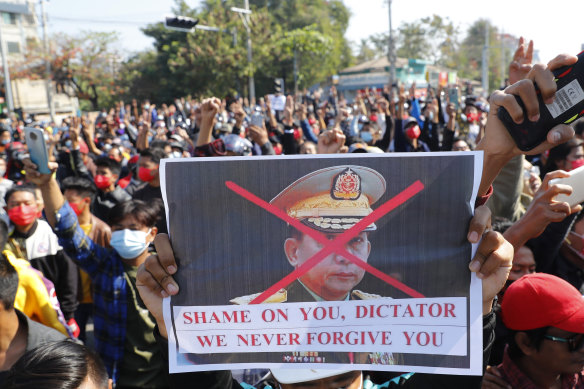
A protester holds a placard with a defaced image of Myanmar military commander-in-chief Senior General Min Aung Hlaing.Credit: AP
What does the military want and why has it struck now?
The military has been involved in politics since independence. Military dictator Ne Win had already served as prime minister when he staged a coup in 1962 that led to the establishment of a one-party, socialist state.
Ne Win stood down during the protests of 1988 but he was replaced by the notorious State Law and Order Restoration Council (SLORC), which detained thousands of political prisoners. It renamed itself the State Peace and Development Council in 1997; armed forces chief Than Shwe led the council from 1992 to 2011 and served as prime minister for part of that time; now 88, he remains an influential behind-the-scenes figure. His successor is Min Aung Hlaing.
These decades of military rule left Myanmar a pariah state. Australia was among the countries that imposed sanctions on the nation after generals rejected Suu Kyi’s win in 1990 elections. Subject to sanctions and reliant on China, the former rice bowl of south-east Asia became an economic ruin, reaching crisis point in 2008 after Cyclone Nargis devastated the Irrawaddy delta, killing 138,000 people. The military was criticised for blocking relief efforts and international aid.
After the disaster, the military began opening up the country to the outside world. In 2011, General Thein Sein became president of a quasi-civilian administration that served as a transition to an elected government. Australia lifted some sanctions in 2012 in response to the moves, although retained an arms embargo.
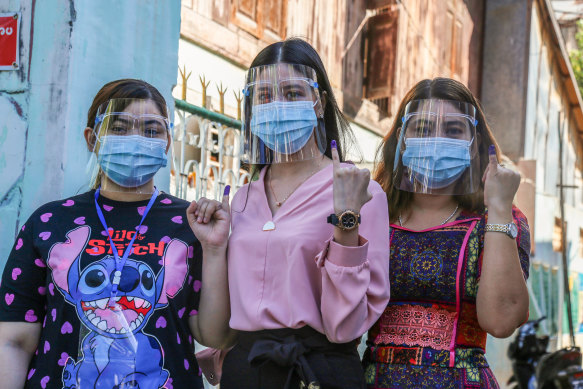
Young women show their inked fingers, a sign they voted in elections in 2020.Credit: Getty Images
But the military ensured the constitution was stacked against the forces of democracy – and Suu Kyi in particular. It has an automatic right to 25 per cent of seats in both houses of Parliament. As any constitutional changes require at least 75 per cent approval in both houses, the military can block any changes it disagrees with. The military also maintains control of key ministries, including Defence, Borders and Home Affairs. The last of these oversees a vast bureaucracy that handles the government’s record-keeping of everything from tax collection and distribution to births, deaths and marriages, and property ownership.
The military also inserted a clause in the constitution forbidding anyone who was married to, or the parent of, a foreign national from being president; Suu Kyi’s sons are both British citizens. To get around this, before the 2015 election Suu Kyi promised voters she would be “above the president”. After the election, she established the position of state counsellor and installed a loyalist as president. She also picked his replacement, Win Myint, who was among those arrested in this recent February 1 coup.
In seizing power, Min Aung Hlaing claimed he was acting in accordance with the constitution. With Win Myint arrested, the military installed former general and vice-president Myint Swe, who authorised the transfer of power.
Min Aung Hlaing has claimed, without evidence, there was “widespread voter fraud” in the November elections. The Myanmar electoral commission had rejected the allegations before the coup. Local independent news magazine Frontier Myanmar reported legal experts questioning the constitutional grounds for the takeover.
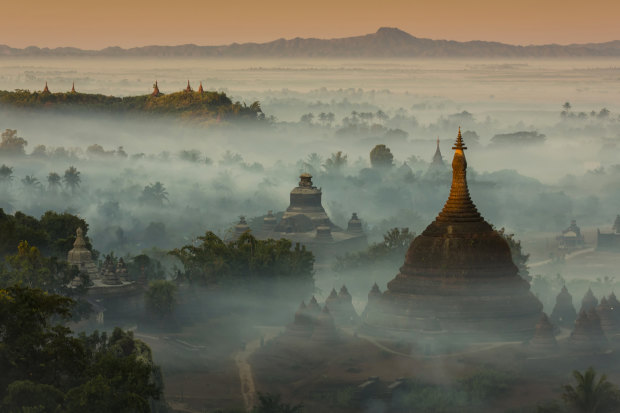
The temples and pagodas of misty Mrauk U, an archeological site in western Burma. Scenes of temples among misty hills are among the sights that had drawn tourists to Myanmar, largely uncharted since colonisation ended. Credit: Getty Images
November’s thumping win for the NLD reduced the military’s proxy party to irrelevance – Tatmadaw won 71 seats out of 1117 in local and national elections, with the NLD claiming 920. (These figures do not include the military’s guaranteed 25 per cent.) The NLD government was due to sit in Parliament with an expanded majority on February 1, but the generals never gave it the chance. The parliamentary humiliation partly explains why the military chose to strike when it did.
Min Aung Hlaing, who has clashed with Suu Kyi over the past 10 years, takes a hard line against reform. Due for mandatory retirement later this year, which sparked questions about his long-term ambitions, he hinted at a move into politics. After the coup, he was denounced by NLD patron and former political prisoner Win Htein for giving “priority to power and his personal desire” over the “best interests of the country”.
What does the coup mean for the Rohingya?
Nothing good. The Muslim minority group has been subject to discrimination since Myanmar’s independence, and conflict flared during the years of military rule. However, since 2012 the Rohingya have been the target of brutal military campaigns in the northern state of Rakhine.
The violence has led to waves of refugees fleeing either overland to Bangladesh or by boat to Thailand and Malaysia. The peak of the crisis came in 2017, when the Myanmar military razed villages, killed and raped an untold number and left almost a million people displaced.
The nation of Gambia has accused Myanmar of genocide in the International Court of Justice; Suu Kyi led the defence in her former capacity as foreign minister. Other cases are working their way through international courts. Other international responses have included sanctions against military leaders, including Min Aung Hlaing.
Meanwhile, Suu Kyi and her government may have done nothing to prevent the atrocities, and actively defended the army – those who committed the violence are now firmly in control of the country.
The coup is also likely to be bad for other ethnic minorities, who have been caught in the world’s longest-running civil wars. The Karen, for example, have been pressing for independence since 1949. With the Tatmadaw in conflict with all main ethnic minorities, Suu Kyi had promised a new approach to a peace process. She had been attacked by Burmese Buddhist ultra-nationalists for even attempting to broker peace.
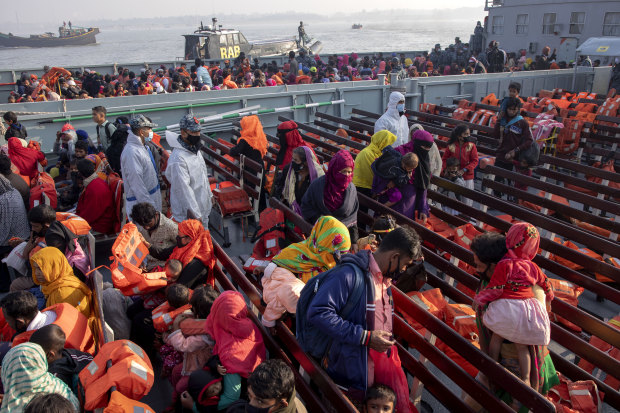
Unable to return to Myanmar for fear of persecution, these Rohingya refugees are on a Bangladesh navy vessel, being moved from an overcrowded camp on mainland Bangladesh to Bhasan Char island, In late December.Credit: Getty Images
What has been the reaction? What could happen next?
On the very day the NLD was due to take power with an enlarged majority, the military reminded everyone it was firmly in control. The announcement that it would be in control for at least a year before another election bodes badly.
In early February, Prime Minister Scott Morrison called the developments “rather disturbing” while US President Joe Biden warned that his administration could reimpose sanctions against Myanmar’s coup-makers. British Prime Minister Boris Johnson condemned the “unlawful imprisonment” of Suu Kyi and said democracy “must be respected”. Beijing noted the developments but said it was an internal affair and urged all sides to resolve their differences, the BBC reported.
United Nations Secretary-General Antonio Guterres said the coup was “a serious blow to democratic reforms” in Myanmar, and the UN Human Rights Council passed a resolution calling for the immediate release of Suu Kyi, Win Myint and others and an end to the state of emergency. On March 31, China blocked calls at an emergency meeting of the UN Secruity Council to impose sanctions, despite a petition from 45 former world leaders and foreign ministers, including Kevin Rudd, calling for action.
A statement attributed to Suu Kyi from detention urged people not to accept military rule but “to respond and wholeheartedly to protest against the coup by the military”. Her supporters have answered the call. In Yangon, protests began modestly but every night progressed to banging pots and pans – a way of warding off evil spirits – in a message people want the junta gone.
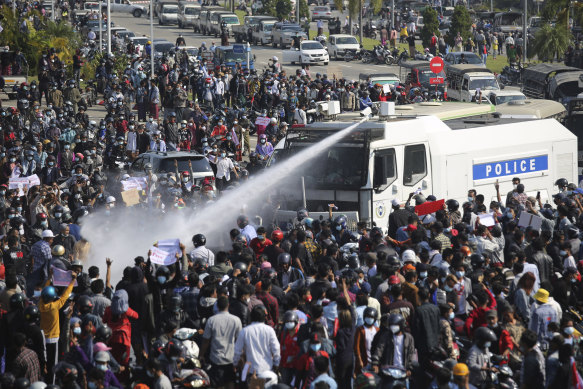
Police spray water cannon on a crowd in Nay Pyi Taw on February 8.Credit: AP
As the days went on, the protests grew in the streets to number in the tens of thousands. Water cannon were used against demonstrators in Mandalay and by mid-February, there were reports of live rounds being fired in Naypyidaw. The demonstrators appeared to have adopted tactics from Hong Kong and Thailand; political figures, activists and unions are among those involved but there is a similarly decentralised leadership structure. The military has moved to hamper mass communication by blocking Facebook, which has a massive number of users in Myanmar, and other forms of social media.
But March brought bloodshed. The killings have escalated, and the death toll passed 500. The deadliest day was March 27, the national Armed Forces Day, when 114 people were killed across the country. This prompted international outrage and condemnation. Human Rights Watch deputy Asia director Phil Robertson says the army and police were shooting protesters in the streets and children in their homes.
“Myanmar’s murderous military showed its true face as it mowed down many peaceful protesters across the country, killing more than 110 people on Armed Forces Day,” Robertson said. “Coup leader General Min Aung Hlaing claimed in his national broadcast that the military would ‘protect people from all danger’ but he and his soldiers are the greatest peril facing the Burmese people. Myanmar’s security forces need to be urgently stripped of the weapons, money and resources that enable them to operate, through a global arms embargo and targeted economic sanctions enforced by a UN Security Council mandate.”
Myanmar-born Sydney woman Sophia Sarkis, a teenager when she fled after her family was targeted in the 1988 crackdown, is among those leading demonstrations in Australia. “We are all emotionally exhausted, our hearts are wounded,” she said. “Our people in Burma, their human rights were simply destroyed by the terrorists. We no longer see them as a military, they are terrorists.
“The security forces, they are meant to protect the country. Instead, they are the ones we need to be protected from.”
This explainer was originally published on February 2 and has been updated to reflect developments.
Let us explain
If you'd like some expert background on an issue or a news event, drop us a line at explainers@smh.com.au or explainers@theage.com.au. Read more explainers here.